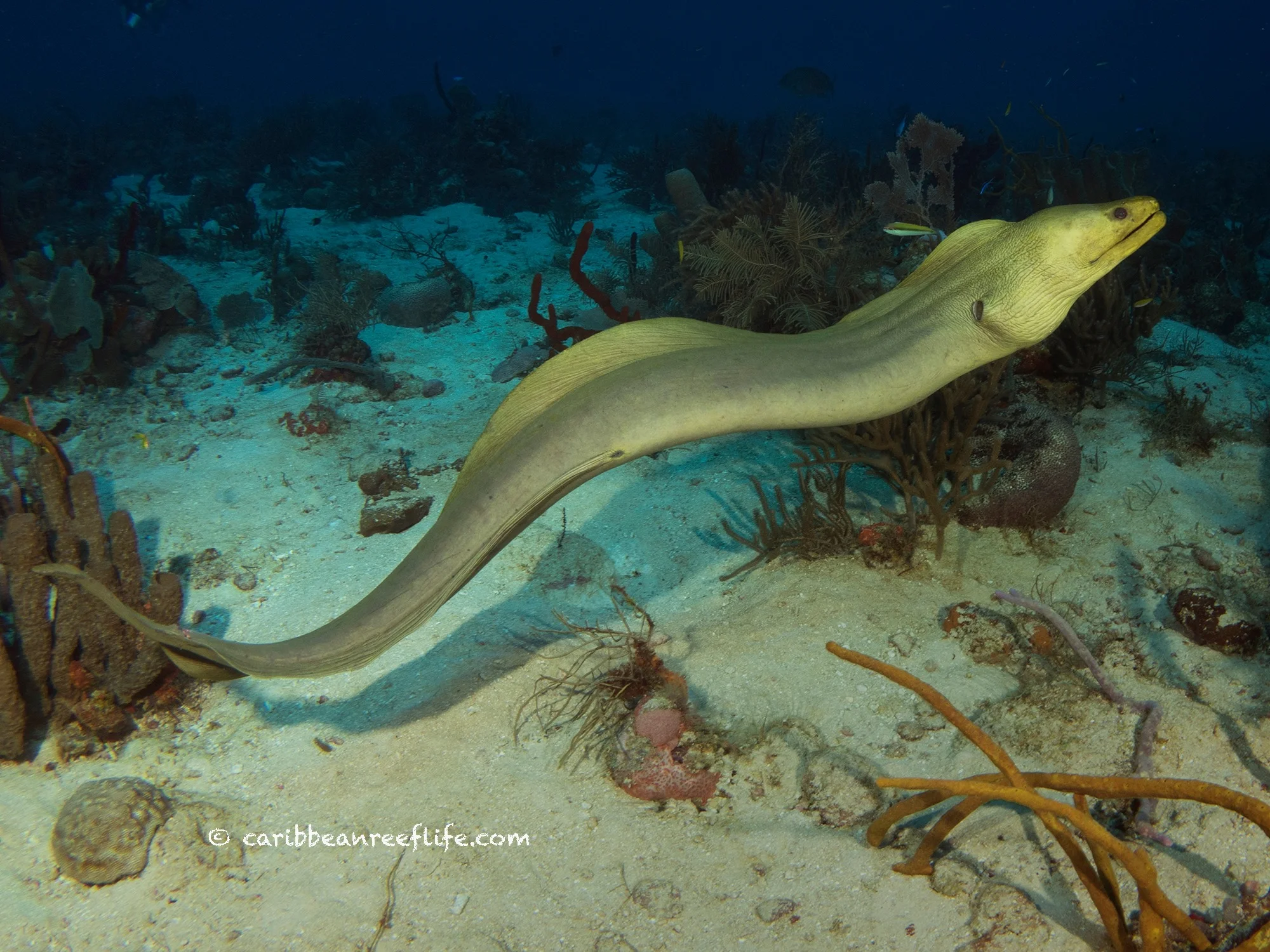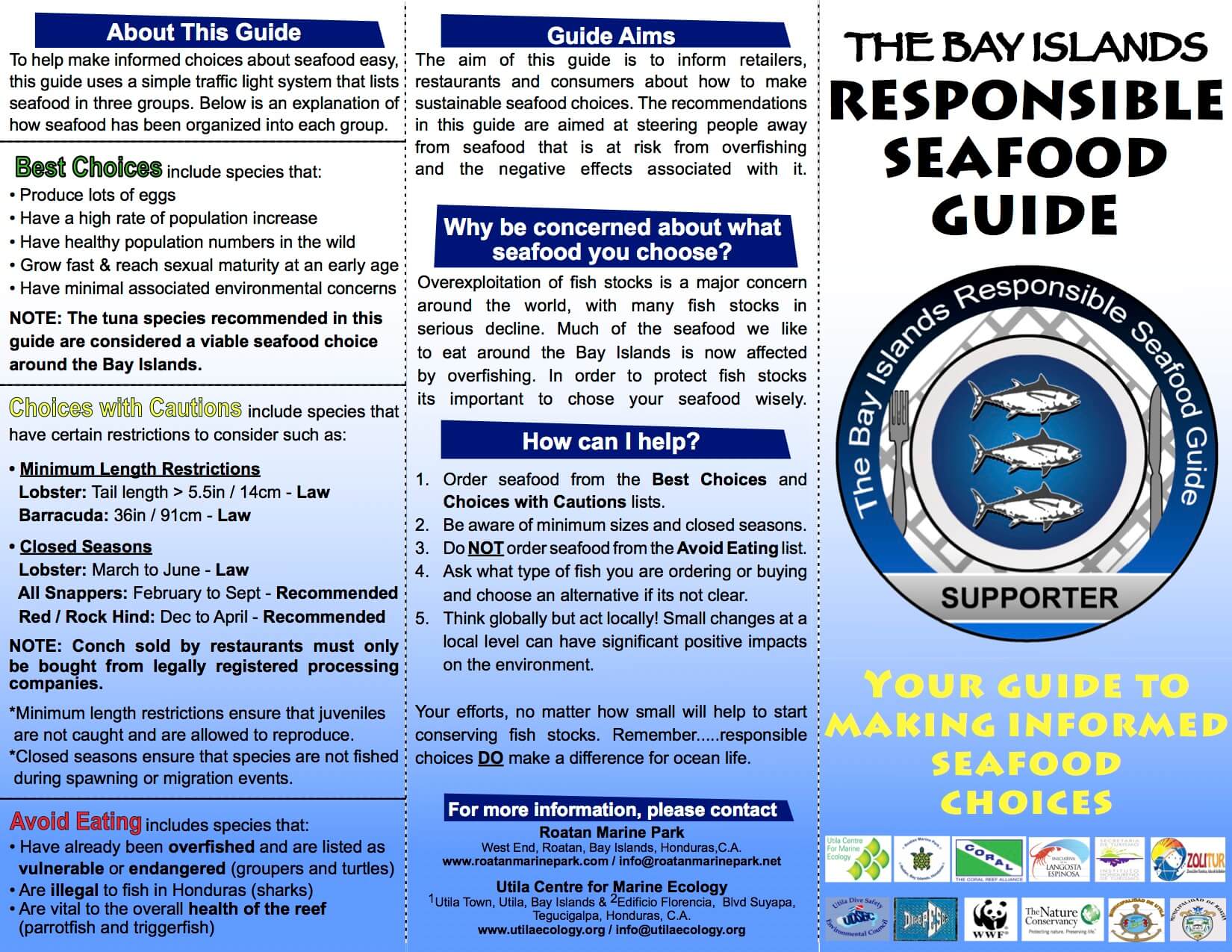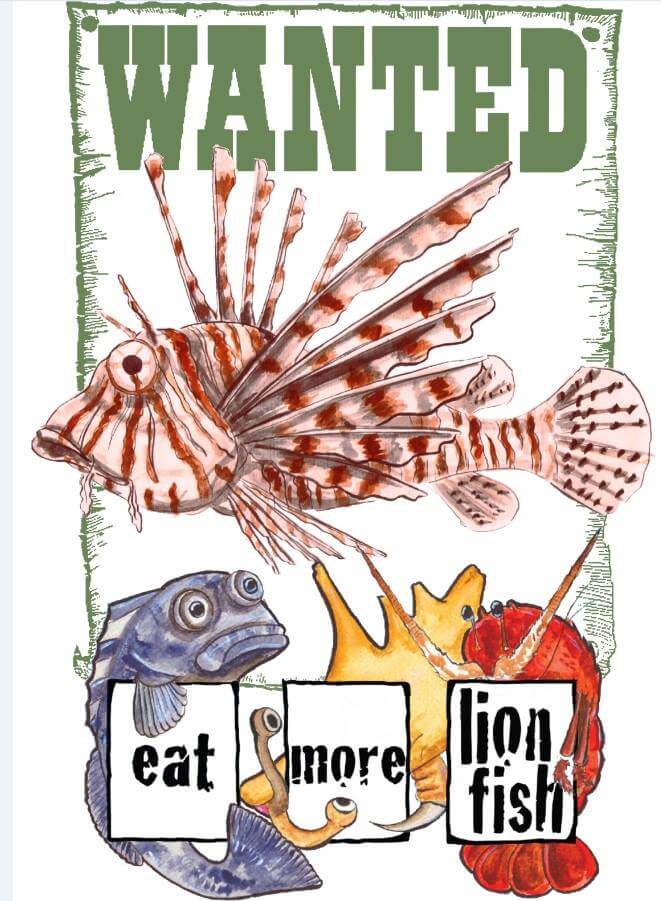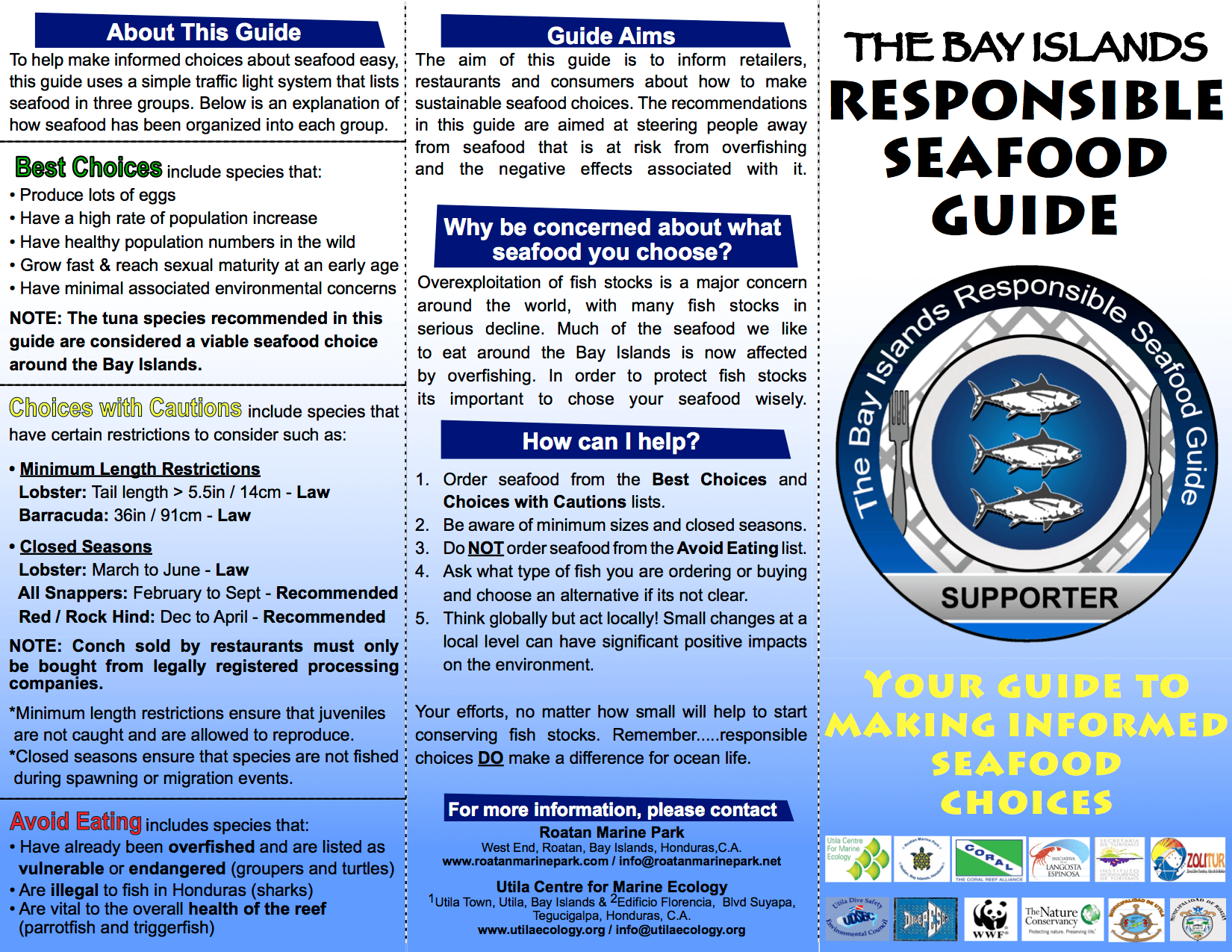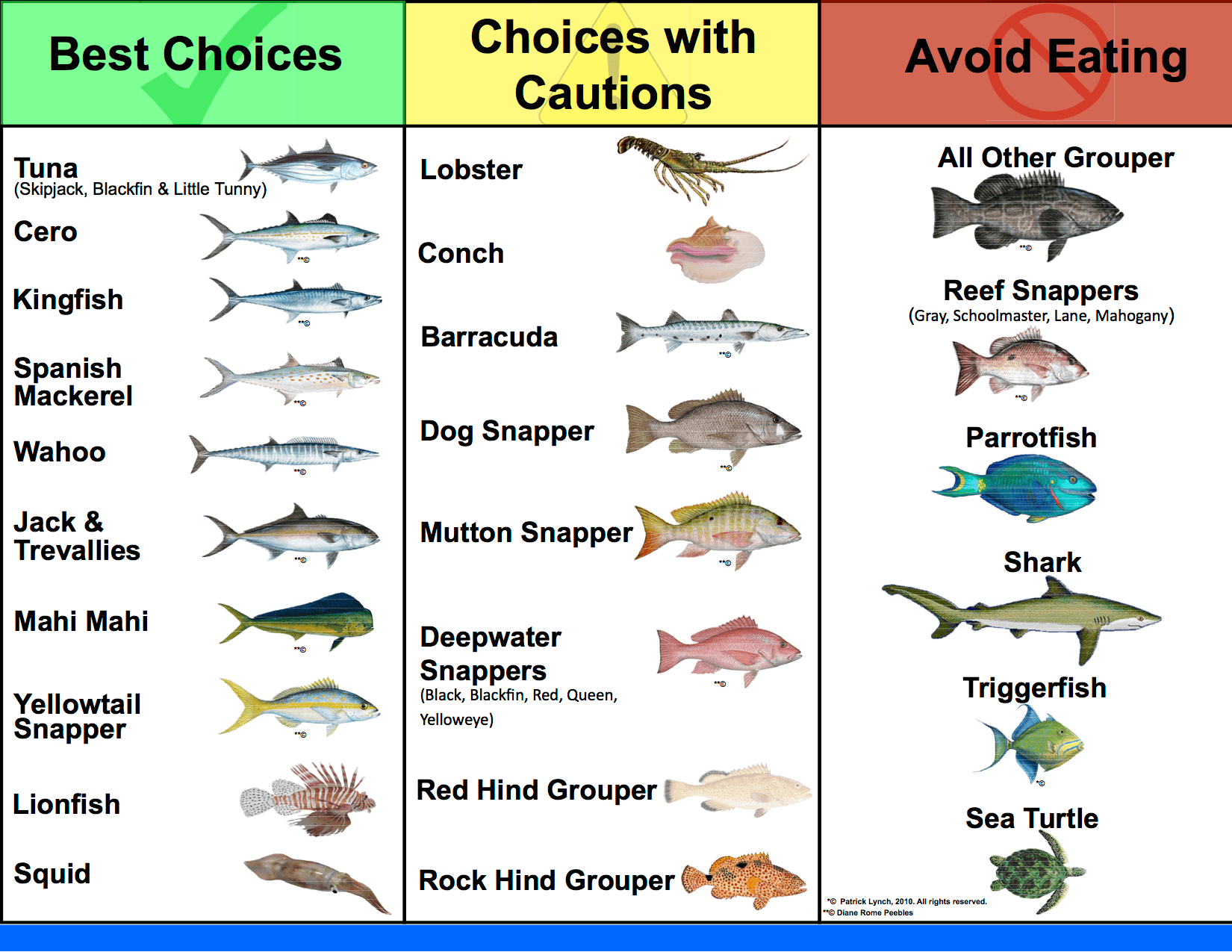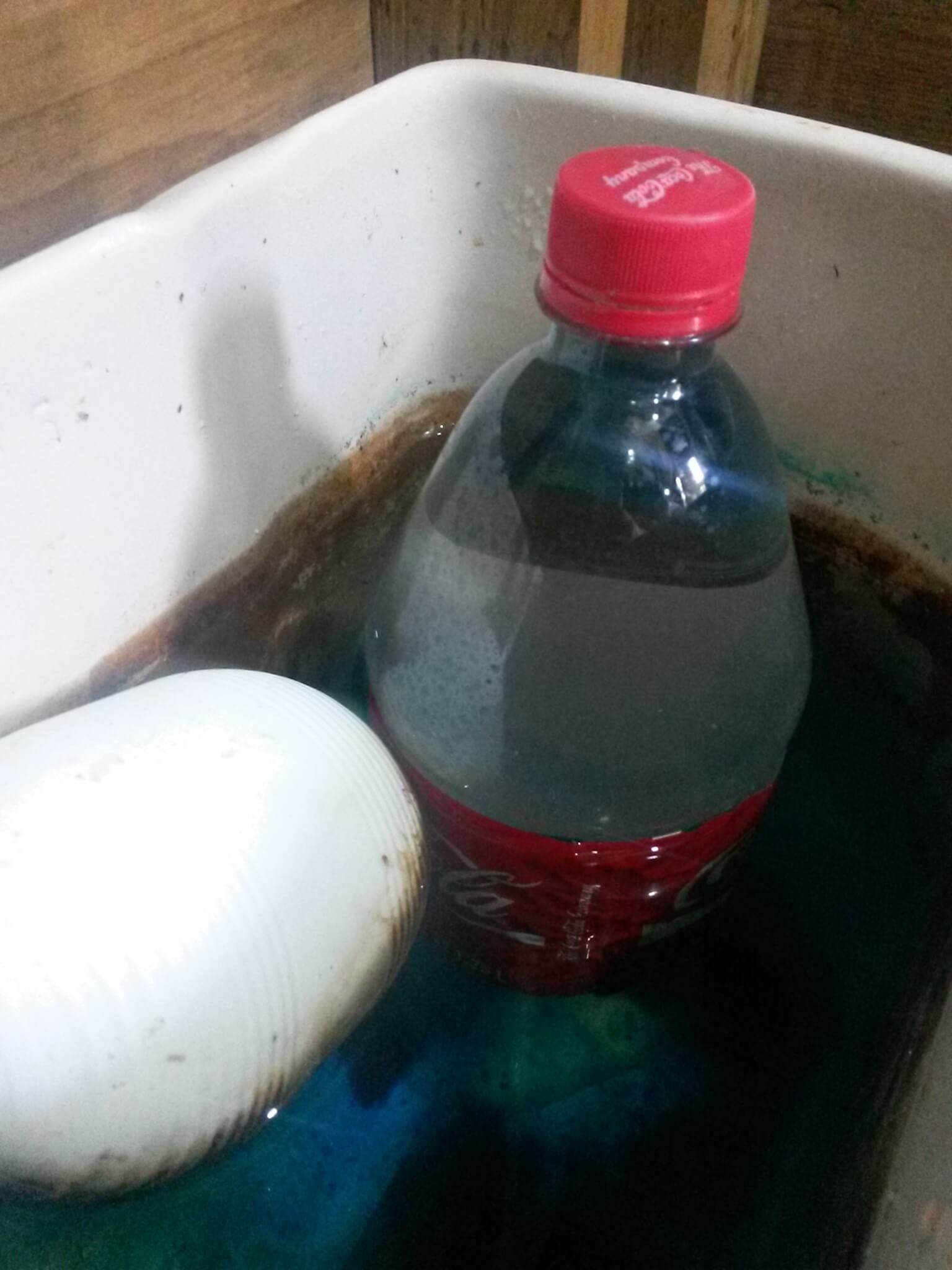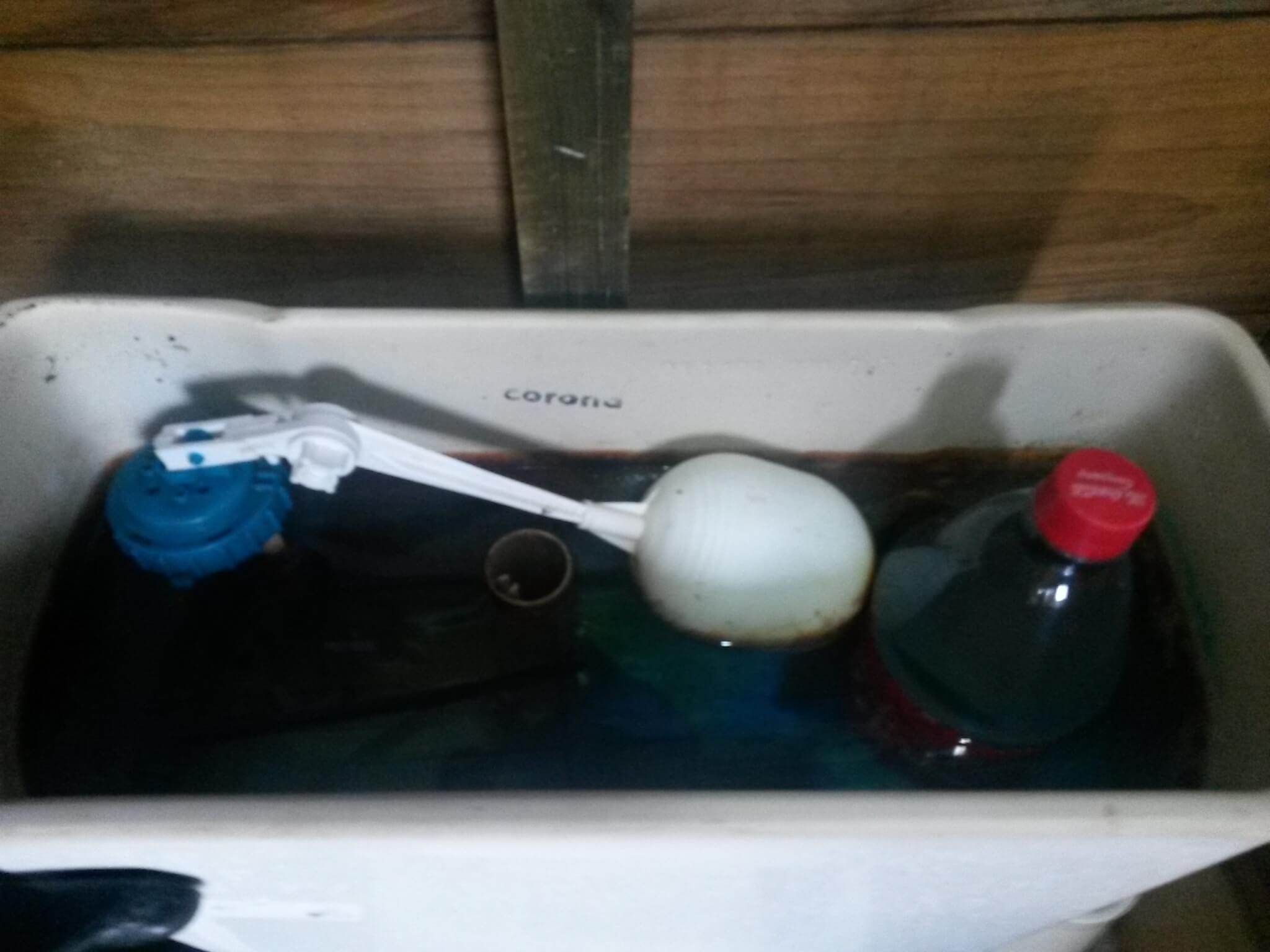3 Cool Facts About Moray Eels
Moray eels are weird. They come in an crazy amount of shapes, sizes and colors, can look really goofy or really intimidating, and all have a variety of behaviors that often means the only thing they have in common is their lack of appendages.
But moray eels are as interesting as they are weird, so let’s learn 3 cool facts about moray eels!
Moray eels are weird. They come in an crazy amount of shapes, sizes and colors, can look really goofy or really intimidating, and all have a variety of behaviors that often means the only thing they have in common is their lack of appendages.
But moray eels are as interesting as they are weird, so let’s learn 3 cool facts about moray eels!
Photo by Caribbean Reef Life
Green Morays are actually brown
Green morays are probably the most common moray we see on Roatan, mostly because they are often free swimming. Sinewy and unafraid, these magnificent animals will glide effortlessly along the reef, stopping occasionally to look into crevasses for food. However, untrue to its name, the true skin color of the green moray is brown. Green morays create a toxic mucus to cover their bodies to ward off predators, and this yellow tinted mucus combined with their brown skin is what gives them their green appearance.
2. Morays are not trying to threaten you
The most common gesture we see in all moray eels is them opening and closing their mouths. In smaller morays, it’s adorable. In larger morays, it’s intimidating, looking like their are gnawing, threatening us if we come closer. But this isn’t the case at all! Moray eels breathe through their gills, but water has to be constantly flowing through their gills to work. When moray eels aren’t moving forward, they still need to having the water flowing, so they “pump” the water through their gills by opening and closing their mouths. This doesn’t mean you should try to manhandle moray eels, though; always remember to practice responsible diving and give them (and all other marine species) a wide berth!
3. Hunting is better with friends!
If you’ve ever seen the green morays free swimming on Roatan, you’ll notice that they’re often not alone. Green morays will often partner with snappers or groupers for a hunt. Like hunting dogs, snappers and groups can point out prey for the green moray to get at, and the fish can close off one end of a crevasse while the moray eel goes in from the other side.
Bonus fact: Humans have created bad habits
Recently, you’ll hear more and more reports about green morays acting aggressive, even biting people. Unfortunately, this behavior was something created entirely by humans. Initially, when divers started spearfishing for lionfish in the Americas, they fed them to morays, snappers and groupers in an effort to encourage these animals to hunt for the invasive lionfish themselves. The feeding did not have the desired effect, instead causing aggressive behavior in these animals towards divers, especially divers with spears. While marine reserves everywhere are trying to rectify this wrong, it’s still important to treat morays, snappers and groupers respectfully, but also be prepared to dump your lionfish loot and run if necessary.
Were there any facts that you didn’t know before this post? Are there other animals you’d like to learn cool facts about? Let us know here or on our Facebook page!
3 Cool Facts About Parrotfish (And Why They Should Be Protected!)
Parrotfish - the unsung heroes of the ocean. Sort of.
Parrotfish are very common around the world and are often viewed as less interesting than turtles or eagle rays. Granted, you see a lot of them on a dive so they’re not exactly rare, but did you know that parrotfish have some pretty cool superpowers?
To show these important and under-appreciated animals some love, check out our 3 Cool Facts About Parrotfish, and see why they, and other herbivorous fish in the Caribbean, are so important for our reef!
Parrotfish - the unsung heroes of our oceans.
Sort of.
Parrotfish are very common around the world and are often viewed as less interesting than turtles or eagle rays. Granted, you see a lot of them on a dive so they’re not exactly rare, but did you know that parrotfish have some pretty cool superpowers?
To show these important and under-appreciated animals some love, check out our 3 Cool Facts About Parrotfish, and see why they, and other herbivorous fish in the Caribbean, are so important for our reef!
Cool Fact #1: They can change sex multiple times
Parrotfish can transition between sexes through most of their lives. The majority of parrotfish are born as females and live in a harem under one Supermale. If the Supermale of the harem dies, the largest female in the harem will transition into a male and take on the Supermale role. You can distinguish between males and females by their colors (the colorful parrotfish are the males), but since they change colors every time they change sex (and even as they move from juvenile into adulthood), it can make classification difficult for scientists!
Cool Fact #2: They make their own sleeping bags
At night, parrotfish will create a mucous sac to sleep in. To this day, scientists aren’t exactly sure why. They have their hypotheses, from the sacs protecting parrotfish from predators by masking their scent, to acting as a barrier against parasites, but nothing has been proven.
When you’re doing a night dive, it’s important to be respectful and not shine your light directly into the eyes of parrotfish (or any other animal, for that matter). When they are startled or woken up, they might break the sac, and may not be able to make a new one that night. This means that not only is the parrotfish disgruntled because they’ve been rudely awakened, but they might be in danger, too.
Cool Fact #3: They create the beaches you love…with their poop
And here is the coolest fact of all and the reason that parrotfish should be protected!
Parrotfish are incredibly important to the health of the reef, because they eat the algae that can smother the reef if left unchecked. That’s why herbivorous fish on Roatan are protected, because we count on them to maintain the health of our reef! That grinding sound you can hear when you’re diving? That’s the sound of many parrotfish “teeth” chewing on bits of coral that they break off when they eat the algae. They poop out the coral as fine particles, creating beautiful, white sand. One parrotfish can create up to 700 pounds of sand in their lifetime, if you can believe it! So that beautiful, sandy beach you’re walking on? Parrotfish poop.
So many coral reefs around the world are suffering because the herbivorous fish populations are being severely depleted, and if we don’t start rebuilding their numbers, the coral itself will not survive. Since you don’t often see parrotfish on the menu in Roatan, you may wonder how their numbers are being so badly depleted. Same as many endangered marine creatures, parrotfish are not only hunted for their meat, but are also getting caught as by-catch by human fishing practices, like trawling and ghost nets. That’s why it’s important for governments to implement marine reserves and also enact laws protecting parrotfish from hunting, so that at least the intentional depletion of parrotfish doesn’t happen.
How can you help?
There are a few ways that you can help the mighty parrotfish survive!
First, if you see it on a menu, don’t order. Herbivorous fish are red-listed in the Bay Islands and in many other marine parks, and it’s important for consumers to adjust the demand so that there is no need for a supply.
Second, it’s important to financially support marine reserves so that they can patrol a greater distance, and more consistently. On Roatan, you can support the Roatan Marine Park by purchasing a yearly bracelet for $10. That $10 donation helps the RMP maintain the dive site moorings, run patrols and educate the community, so they play a very important role in the health of Roatan’s reefs.
Now, go enjoy an awesome dive on Roatan and take a minute to appreciate a parrotfish when you see one!
Interested in more 3 Cool Facts posts? Let us know what animal you want to learn about next!
5 Cool Facts about Turtles for World Turtle Day
Happy World Turtle Day!
Let's face it, who doesn't like turtles? That's probably what gets requested the most from our divers, and with a well-protected marine park, it's very easy to deliver. Turtles are interesting animals, with personalities and fun quirks, so what are 5 Cool Facts that you should know about turtles today?
Happy World Turtle Day!
Let's face it, who doesn't like turtles? That's probably what gets requested the most from our divers, and with a well-protected marine park, it's very easy to deliver. Turtles are interesting animals, with personalities and fun quirks, so what are 5 Cool Facts that you should know about turtles today?
Fact 1. The green turtle has green insides
You may have noticed that green turtles are not particularly greener than any other turtle species. In fact, when they're babies, they're black! The green turtle is actually named that because the layer between its organs and its shell is green, not because its shell is.
Fact 2. Turtle shells are part of them
Unlike tortoises, turtle shells are not a separate piece of material covering their backs. Their shells are their backs. That's why if they get shell injuries, it can be life threatening, because it's basically the same as a human getting a wound on their backs.
Just keep swimming!
Fact 3. Baby turtles swim for 4 days straight after they're born
When we were diving in the Bonin Islands of Japan, we visited a turtle sanctuary that's done some phenomenal work in the area. We got lucky and went there after a group of hatchlings were born 3 days earlier. Inside their swimming pool, they just kept swimming...and swimming...and swimming. Baby turtles are hardwired to swim for days into open ocean before they find floating seaweed or something to rest on, so these little guys just kept swimming in circles for the first few days after they were born.
Fact 4. Only 1% of turtles make it to sexual maturity
Crazy! Out of all the turtles born all over the world, only 1% will survive to reach sexual maturity. The majority of turtle babies never make it past the beach on their first day alive. This is why it's so important to protect the turtles that we have left, because human interference and consumption has not made things easier for these guys. Although many turtles species are now protected, boat activity, trawling and hunting are decimating turtles numbers around the world. For a population that already struggles to survive, it's a severe blow.
Fact 5. Hawksbill shells are still being exploited
Classified as Critically Endangered by the World Wildlife Fund, Hawksbill turtle shells are most threatened by the illegal wildlife trade. Their brown and yellow patterned shells commonly referred to as "tortoiseshell" are extremely popular and can sell for a high price. While most tortoiseshell products are now made out of synthetic materials, there is still a startling amount of illegal trade of their shells and products. To ensure you are buying the fake tortoiseshell from the real ones, we suggest you consider the price, is the vendor reputable and most of all the detailing on the object. Real tortoise shell is hand carved so it will have small imperfections along with a higher price tag.
Show your turtle love!
For all the turtle lovers out there, here's a few ways we can be heroes to these adorable reptiles on World Turtle Day:
Reject Turtle Products - Turtles are critically endangered all over the world, exploited for their shells and their meat. As long as a demand exists, so will a supply, so make sure to avoid purchasing turtle products wherever in the world you go.
Use Reusable Bags - Plastic bags floating in the ocean look almost identical to one of their favorite foods, jellyfish and turtles mistakenly ingest it. Add this to the long list of reasons of why reusable bags should be a part of your daily living!
Respect Turtles in their Natural Habitat - Whether you're diving or snorkeling in the Bay Islands, it's illegal to touch, chase, harass or ride them. Also if you're lucky enough to be near a beach area where turtles lay eggs, it's critical to keep a safe distance from hatchlings and be mindful not to confuse the younglings with any artificial light like camera flashes at night. Keeping a safe distance helps ensure that turtles & many other marine animals are not harmed as a result of human interaction.
Resist Disposable Utensils - From plastic straws, forks, spoons and knifes and more, the volume of plastic debris that ends up in the ocean is staggering. Sea turtles and many other marine animals ingest it, causing blockages in their digestive track. Turtles fights to expel these foreign objects, as seen in the infamous turtle straw removal video, but ultimately many cannot, leading to death.
To learn more, check out our 5 easy ways to live more eco friendly.
When is Roatan's Lobster Season?
Demand for lobster is high, and the restaurants will continue to serve illegal lobster as long as patrons continue to request it. It's our responsibility as visitors to encourage responsible and sustainable seafood consumption so that local providers providers will follow suit, benefiting both the environment and the local economy.
All marine reserves have fishing regulations, and Roatan is no different. While most people come to the Caribbean with the thought of eating lobster on the beach, it's important to know when Roatan's lobster season is, and what the lobster regulations are even when they're in season, to ensure that you are not putting an additional strain on the environment and ruining the marine world that Roatan is renowned for.
Lobster is in season on Roatan from July 1st to February 28th (or 29th on leap years), and only fishermen with lobster fishing permits are allowed to catch lobster outside of the Roatan marine reserve. Their tails must be greater than 5.5 inches, or 14.5 centimeters in length. Undersized lobsters are illegal, regardless of if a permit carrier catches them, and it is illegal to go diving for them within the reserve.
Poached lobster, photo courtesy of Roatan Marine Park
Unfortunately, demand for lobster is high, and the restaurants will continue to serve illegal lobster as long as patrons continue to request it. It's our responsibility as visitors to encourage responsible and sustainable seafood consumption so that local providers providers will follow suit, benefiting both the environment and the local economy.
How do I enjoy lobster responsibly?
- Only enjoy fresh-caught lobster between July 1st and February 28th and NOT between the months of March and June.
- When dining in Roatan, ask the restaurant where the lobster was caught. If they respond that it's locally caught, ask about the size of the tail. Remember, they must be larger than 5in/14.5 cm.
- Look around your restaurant for displays of the Bay Islands Responsible Seafood Guide.
- Keep an eye out for warning signs - if you're served lobster that still has its head, it is most likely poached from local, protected waters. Report suspicious activity to the Roatan Marine Park.
For more information regarding Roatan's fishing regulations and environmental laws, go to the Roatan Marine Park's website and learn how to be a responsible tourist today.
The Bay Islands Responsible Seafood Guide
Whenever you visit somewhere new (or even at home), it's important to think about responsible consumption when you're making your dining choices. The Bay Islands developed a helpful visual guide to point out which fish in these waters that are the best options and which are ones that should be avoided. Have a look before you dig in!
Whenever you visit somewhere new (or even at home), it's important to think about responsible consumption when making your dining choices. Overfishing has run many of the waters around the world dry, and responsible seafood recommendations have been put in place all around the world to help combat, or at least slow, the killing of our marine ecosystem.
The Bay Islands developed a helpful visual guide to identify which fish make the best options and which ones should be avoided. Let's have a look before you dig in at the dinner table!
From the Best Choices list, the fish we enjoy eating and frequently find are responsibly fished here in Roatan are:
Tuna
Lionfish
Wahoo
Mahi Mahi
When you are dining out here in Roatan, look for this visual guide which is proudly on display at many local restaurants. Tuna is a great example of a popular and plentiful fish here, but in other parts of the world is sadly often overfished. Keep in mind, a fish that might be a responsible choice in some areas might NOT be in other geographic areas. It really can vary.
We caution or discourage guests from the following items that are commonly poached, caught illegally, overfished, or caught without meeting the proper restrictions.
Conch
Lobster (Only in season from July through February)
Snapper
Grouper
Below you will find a detailed guide with more information and learn how you can get involved. Without the demand for fish that are at risk, there will be no supply! Please think how you can help protect Roatan's local fish populations by sharing this with others and making responsible seafood choices when you dine out.
Eat More Lionfish
We couldn't resist the opportunity to encourage our seafood enthusiasts to give this tasty fish a chance. The fillet is not very oily or fishy tasting, so there is a lot of variety for how it can be prepared and the flavors you can enjoy!
Interested in hunting lionfish to help bring this invasive species directly to your plate at home? Learn how you can obtain a Bay Islands Lionfish Spearing License from the Roatan Marine Park's Invasive Lionfish Control Program.
Bay Islands Lionfish Spearing License
As a marine reserve, it's illegal to spearfish in the Roatan Marine Park. Lionfish are the exception, since they have no natural predators in the Americas and their venomous spines provide a strong defense against potential predators.
The lionfish is a majestic creature. With beautiful coloring and amazing structure, there is something magical about watching a lionfish riding the current off the reef. If you're diving in Southeast Asia or Australia, it's always a delight to see these fish, and as professional divers, we love pointing them out to our guests.
However, as many of you know, lionfish are not endemic to the Caribbean. There are many viable theories as to how they were released, but most point to the private aquarium trade. As a result of them accidentally being released in this area, their numbers have exploded and people all over the Caribbean and Americas are struggling to curb their population.
Photo credit Roatan Marine Park
As a marine reserve, it's illegal to spearfish in the Roatan Marine Park. Lionfish are the exception, since they have no natural predators in the Americas and their venomous spines provide a strong defense against potential predators. As a result, the Roatan Marine Park Invasive Lionfish Control Program was developed as a proactive measure to get the local community, snorkelers, and divers involved in helping curb lionfish numbers in these waters.
To obtain your Bay Islands Lionfish License, you start by attending a workshop conducted by the Roatan Marine Park that teaches you about proper spear usage, education on hunting regulations, and includes an in-water skills assessment using coconuts as target practice. In the water, it's important to demonstrate good spatial awareness and buoyancy, since the purpose of hunting lionfish is to protect the reef, and if you're banging all over it and killing the coral, it defeats the purpose of this program. The Roatan Marine Park Lionfish License is $50 and includes a registered spear, the workshop and your license, which is valid for 2 years. The Roatan Marine Park normally runs these workshops twice a week from their Eco Store in West End based on interest, but they can run special workshops for larger groups as well.
We love it when we hear divers express an interest in lionfish hunting. From eating a tasty sustainable guilt-free fish option to competing in our annual Roatan Lionfish Derby, or for the thrill of the hunt while helping defend the reef, there are so many good reasons to support Roatan's lionfish program. Talk to your dive center and see how you can get involved today!
We Found Our Eco Gear!
Rejoice, Team RD-ers! After searching the streets of Tokyo for the perfect eco gear, we have finally found what we were looking for.
Rejoice, Team RD-ers! After searching the streets of Tokyo for the perfect eco gear, we have finally found what we were looking for.
After joining Go Blue Central America this year, we wanted to take the bull by the horns and implement more and more eco ideas to help minimize our impact on the environment. Per our conservation initiatives, we will have "rental" takeaway containers and reusable bags at the dive center for our guests so we can help cut down on styrofoam and disposable plastic consumption on the island. We purchased high quality, microwavable rectangular 1.8 liter containers (for those big island lunches) and circular 590 ml containers (for soups and smaller fare) for your takeaway needs, as well as forks, spoons and knives if you want to eat at the shop.
We will also have reusable shopping bags for you to use, both for light West End shopping trips and for your bigger grocery trips to Eldon's Supermarket.
Let's help make Roatan more eco, one box at a time!
3 Easy Environmental Improvements We Made with Go Blue Bay Islands
As you guys know by now, Roatan Divers joined Go Blue Central America Geotourism recently, and completed our first environmental assessment last month. We discussed the things we were doing well on environmentally and things that could be improved on, and after the assessment we decided to grab the bull by the horns and implement what we could as soon as possible (before the results even came out!). We have our next assessment coming up in a week, and we're excited to show you some of the changes we've already implemented and to learn more ways that we can promote responsible tourism on Roatan.
As you guys know by now, Roatan Divers joined Go Blue Bay Islands in partnership with National Geographic and we completed our first environmental assessment last month. We discussed the things we were doing well on environmentally and things that could be improved on, and after the assessment we decided to grab the bull by the horns and implement what we could as soon as possible (before the results even came out!). We have our next assessment coming up in a week, and we're excited to show you some of the changes we've already implemented and to learn more ways that we can promote responsible tourism and environmentally friendly business practices on Roatan.
1. We installed a water efficient shower head
We know you guys all love our hot water shower and its amazing water pressure, so we wanted to make sure that we could have a water efficient shower head without compromising pressure. We found the perfect shower head that still offers a lot of power, but outputs 1.5 gallons of water per minute at its medium setting, far less than our previous shower head which was basically an Amazonian squall falling on your head. We haven't had a new water bill since we've installed it, but we're interested to see how things change next month.
2. We set up an informational display regarding poaching
A while back, a guest bought a conch shell from a street vendor without realizing that it's a threatened species, and donated it back to the dive center. We had the option of taking it back out to sea or using it as an educational tool, and decided to go the educational route to ensure that all of our guests are aware of the dangers of the illegal wildlife trade. The Roatan Marine Park kindly donated a few more confiscated items to fill out our display better, but we previously did not have a sign explaining why these items were on display, and the items were just placed in the corner without much fanfare.
After our first environmental assessment with Go Blue Central America, we set up a proper display shelf with information regarding poaching in an effort to inform as many people about the importance of responsible tourism. We also have a poster up with the Responsible Seafood Guide and information for minimizing plastic consumption, and this has inspired a lot of conversation regarding conservation so we're very excited about where all this will lead.
3. We reduced water consumption in the bathroom
As a dive center, we have a lot of people using the washroom facilities, and use a lot of water every day between the toilet, sink and shower. We're already reducing our water consumption with the water efficient shower head, but we wanted to take it a step further. To reduce our water consumption in the toilet, we place a full water bottle into the tank to increase displacement so that the tank would have to fill with less water to get full.
These were 3 very easy ways that we could reduce our environmental impact and increase awareness about responsible tourism. Each change required very little effort and money, but will make a greater impact in the long run. While we try to be as environmental friendly as possible, it's nice having an outside, professional source offer different ideas to further increase our environmental awareness, and we look forward to continuing our work with Go Blue Central America to support an environmental responsible tourist destination.
Make sure to check out Go Blue Central America's website and Facebook page for more environmental tips and see what businesses are getting involved!

